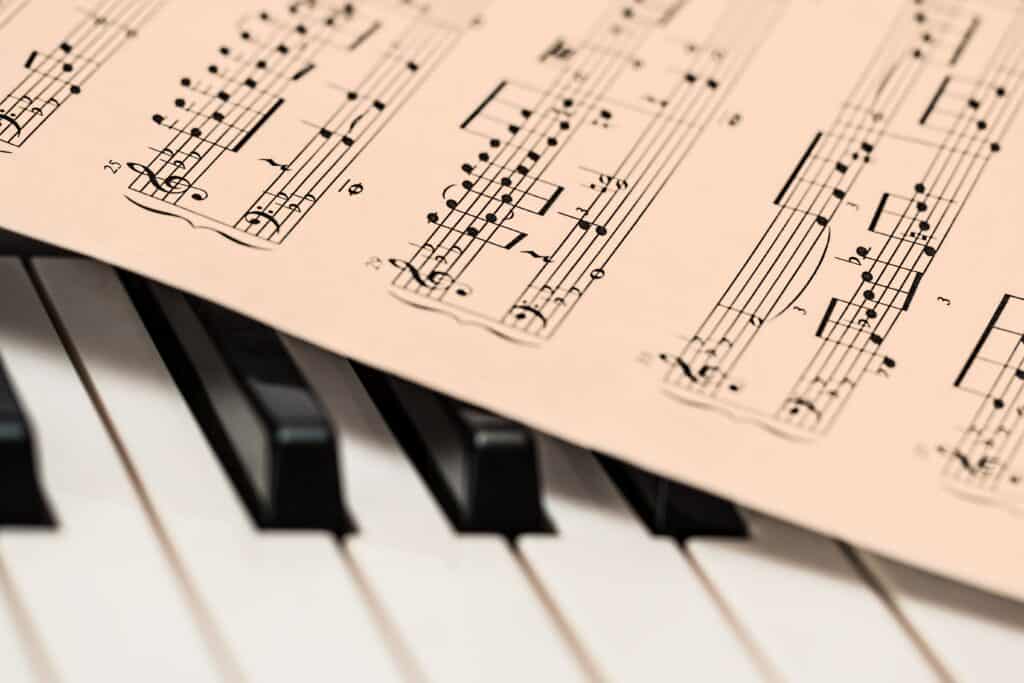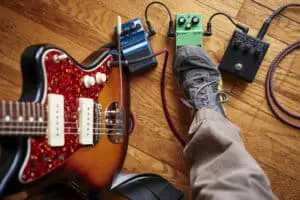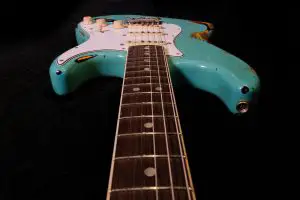
Getting Modal Theory Out of Your Head and Onto the Fret Board
Whenever I’m asked for an explanation or example of what I was thinking when playing phrase X or solo in song X, inevitably my explanation gets around to a mode of the major scale at which point their eyes glaze over and the usual look of “oh no not another musical math lesson” springs forth.
There are many ways to conceive of modes, such as memorizing intervallic relationships, whole tone and semi tone (whole step – half step) relationships, the assembly of notes in each key, etc., all of which are valid and some quite necessary…eventually. The problem is that knowledge doesn’t always translate easily to the fretboard.
For me, when I first started actually applying modal theory to the fretboard I did so by understanding that modes of the major scale are in fact just major scale patterns with variable root notes.
In other words, each of the seven modes contains the same set of notes as a major scale of another key. The trick is to learn the placement of the major scale pattern for the mode you are trying to create.
Likewise, you don’t have to learn new patterns, you are simply “shifting” the major scale patterns that you already know to the correct position on the fretboard to create the interval structure you are after. Each of the seven modes contains the same set of notes as some other major scale. Hopefully the light bulb will go off here shortly.
Using What You Already Know
I’m assuming you know at least one major scale pattern.
If you don’t, I would suggest some of the easier fingerings of the major scale. Three notes per string patterns are perhaps the easiest to memorize since they contain many repeated fingerings on adjacent strings.
Figure 1 shows a three note per string scale in G.
It’s extremely important that you understand and memorize the root note(s) in any pattern as it is applied as a major scale. For example, if you are playing a new major scale pattern in the key of A then make sure you memorize where the A (root) notes are in the scale pattern.
The pattern and the root in the pattern is what are important which does not change as you move the pattern up or down the fretboard. The letter notes change but the pattern and the location of the root in the pattern itself does not change. That’s what needs to be memorized first so you can progress to applying modes.
Figure 1
G Major – Root notes are in bold
E————————————————5–8–7—————-
B—————————————5–7–8————————-
G——————————4–5–7———————————-
D———————4–5–7——————————————-
A————3–5–7—————————————————-
E—3–5–7————————————————————-
By moving the pattern you are in effect changing the root note of the pattern to create the “mode” you want because all of the interval relationships between the notes change when you change the pattern position and therefore the root note.
This is because the interval relationships are created by the distance between the root (or inferred root note) and the other notes in the pattern.
If you play a G major scale pattern starting with G as your root note then you have G Ionian mode (which is the same as major). If you play the same pattern but use the second note in the scale (A) as the root note then you just played A Dorian mode, do the same on the third note…you get B Phrygian mode…the forth note C Lydian mode…the fifth note D Mixolydian mode…the sixth note E Aolian mode…the seventh note F# Locrian mode.
So let’s take this information and make it simple so we can get on the fretboard quickly.
Shifting Patterns
The point is that you don’t have to learn any new patterns to play all the modes of the major scale. You just have to shift the major scale pattern to the right position on the neck so that the root note is in the proper place. It might be confusing at first but it makes sense when the light bulb goes off.
When practicing it is important to have appropriate accompaniment in which to hear the modal qualities develop.
The root and chord/progression is what determines the intervallic relationships and therefore the mode. So record yourself playing some agreeable chords that are appropriate for the mode you are practicing. This will help you to hear and later recognize the tonality of the mode you are trying to master.
Figure 2 lists the seven modes and describes how to locate the corresponding major scale for each. It is intended to help you quickly shift a major scale pattern to a location on the fretboard that will create the interval relationship needed for the mode desired.
If you wanted to practice B Phrygian mode you would play a major scale pattern of the note that is two whole steps down (G) however you would consider B as your root.
In other words, a G major scale played over a B minor chord/progression gives you the notes (interval relationships) required for B Phrygian.
This is because Phrygian requires you to use the third note of the major scale as your root in this case B. So if you play a major scale two whole steps down (4 frets) from B in this case G major, your third note lands on B.
This is consistent no matter what key you are in. A major scale two whole steps down from your key root always produces Phrygian mode. However, use agreeable chords to hear the right tonality. You wouldn’t “hear” the Phrygian tonality over a major triad for example.
Figure 2 shows how to apply this to all the modes.
Figure 2
| MODE | Play a major scale pattern |
| IONIAN | Beginning on the same note as the major scale root (same as major) |
| DORIAN | One whole step down from key root |
| PHRYGIAN | Two whole steps below the key root |
| LYDIAN | A perfect 5th above the key root (or 3 ½ steps above) |
| MIXOLYDIAN | A perfect 4th above the key root |
| AEOLIAN | A minor 3rd (3 frets) above |
| LOCRIAN | A one half step above the key root |
Agreeable Chords
Figure 3 lists basic agreeable chords for the modes of the major scale. Make sure you have background accompaniment with agreeable chords to begin hearing the tonality of the modes.
Figure 3
| IONIAN | DORIAN | PHRYGIAN | LYDIAN | MIXOLYDIAN | AEOLIAN | LOCRIAN |
| Major | Minor | Minor | Major | Dom7 | Minor | Minor |
| Major7 | Minor7 | Sus7b9 | Major7#11 | Dom9 | Minor7 | Minor7b5 |
| Major9 | Minor9 | Dom7b9 | Major9#11 | Dom13 | ||
| Major13 | Minor11 | Dom7b9 |
The best part of this approach is that you can increase your vocabulary of lines seven fold by simply applying major scale licks against different chords/progressions.
This is only a starting point to get you in the right pattern of intervals for the mode you want. Once you are able to physically play the patterns in their appropriate locations on the neck to attain the mode you want, then you can start to phrase the notes in the pattern to achieve the modal tonality you desire.
There is a lot more to learn here such as memorizing the intervals that are unique or can be punctuated for each mode, memorizing several major scale patterns and the roots in each scale pattern, and memorizing the diatonic chord scale, etc.
Furthermore, using modes exclusively can sound quite sterile. I would suggest getting familiar with blues scales and where those blue notes are in relation to the minor or dominant mode you are using as well.









